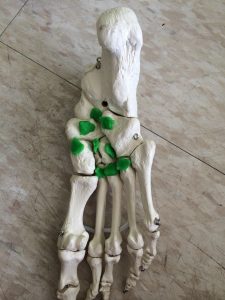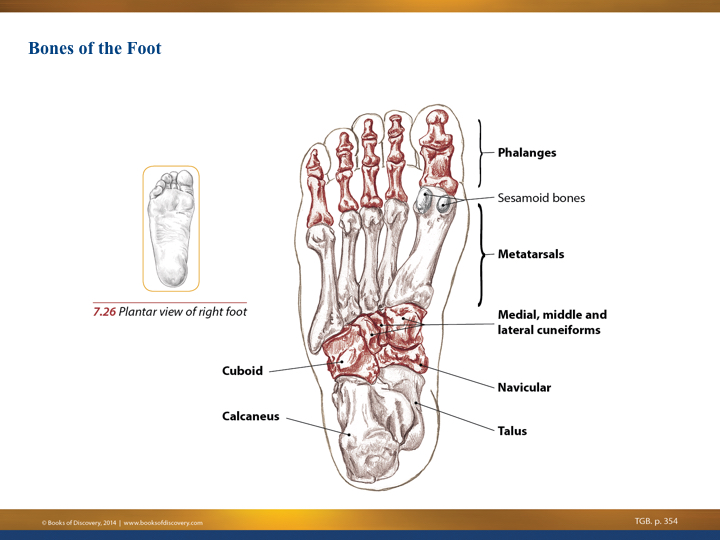When a client asks you, “What do you think about arch supports?” You can respond by educating them and connecting them to the tibialis posterior muscle. The tibialis posterior covers a lot of bone in the lower leg making it important to know about. Especially since it is essentially the best all natural arch support for your foot.
Tibialis Posterior Muscle Attachments

The tibialis posterior starts at the posterior tibia and fibula, wrapping around the medial side of the lower leg and attaching on the plantar side of the foot.
Here are the attachments:
Proximal, posterior shafts of tibia and fibula; and interosseous membrane
Bases of metatarsals 2,3,4
All 5 tarsals (navicular, 3 cuneiforms, cuboid)
Don’t get lost in the complicated anatomical words.
Find this muscle on yourself. Palpate between the posterior tibia and fibula bones on the back side of your lower leg. It’s probably tender in there.
Now, look at the green play-doh on Andy the skeleton to the right while palpating the underside of your right foot. Locate the bones that you see in the photo by feeling around for them. If it’s tender you are in the right area!
It can take awhile and practice to find the attachments on the plantar surface of your foot. But, it’s a nice massage while you explore.
Tibialis Posterior Muscle Actions
- Ankle plantar flexion
- Ankle inversion
- Ankle adduction
- Foot supination
This fourth movement is the one that is referenced in the title. Supination is usually a term learned for forearm movement, with the opposite being pronation. It’s also a term used for the foot. Supination happens when the arch becomes rigid for push off. It’s essential to get the foot, leg and entire body moving forward for every step you take.
Envision the tibialis posterior muscle attachments under your foot getting pulling medial and superior toward the posterior tibia and fibula attachments. The motion is similar to what would happen if you tried to pick a pen up off the floor with your foot. Your toes would do the grasping, but imagine what the rest of the foot and ankle would do.
Doing this motion into the ground instead of trying to pick up a pen causes locomotion.
Tibialis Posterior Exercises
Since tibialis posterior is the most natural form of arch support for the feet, it’s important to build awareness around this muscle and strengthen it for yourself and your fitness clients.
Return to the motions that this muscle does to create an exercise for it.
1. Press the big toe into the floor to create an exaggerated arch of your foot warm up the muscle and build awareness.
2. Continue the first motion into a calf raise, slowly. Stop when you lose connection with tibialis posterior.
3. Continue the first motion, pressing the big toe into the floor while also adducting the foot toward the midline. Feel the attachments on both sides of the muscle contract while you hold this position for 5-10 seconds. When done properly it’ll burn more than a 200 lb. bench press.
4. While walking, focus on this muscle to connect with it. Palpating it before a walk can help bring awareness and blood flow to the muscle.
The tibialis posterior muscle is just as important as the other 600 muscles in the human body. But, it’s often over-looked during traditional fitness programs. Tibialis posterior awareness and strength is the answer to many big questions that arise in the realm of exercise. Learn more about it, connect to it and lead your clients to better movement.
Learn more about the significance of muscle attachments and their role in exercise by taking NFPT’s Fundamentals of Anatomy Course this year.
[info type=”facebook”]Join the conversation. If you’re an NFPT trainer, join the Facebook Community Group to chat with other trainers. If you’re not, come talk with NFPT here, like our page, we would like to meet you![/info]
Reference
Biel, Andrew. 2014. Trail Guide to the Body. Boulder: Books of Discovery
Beverly Hosford, MA teaches anatomy and body awareness using a skeleton named Andy, balloons, play-doh, ribbons, guided visualizations, and corrective exercises. She is an instructor, author, and a business coach for fitness professionals. Learn how to help your clients sleep better with in Bev's NFPT Sleep Coach Program and dive deeper into anatomy in her NFPT Fundamentals of Anatomy Course.


